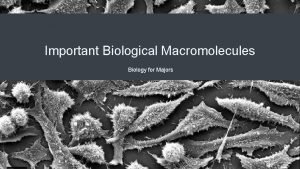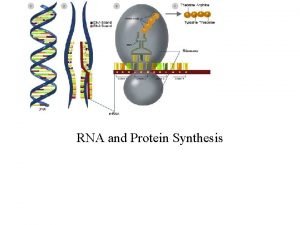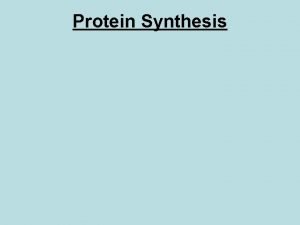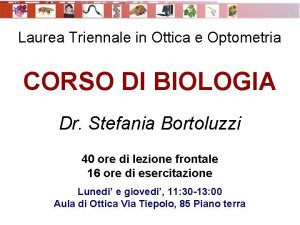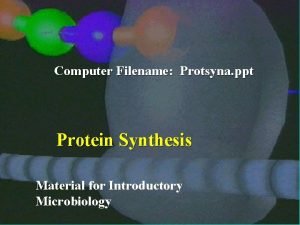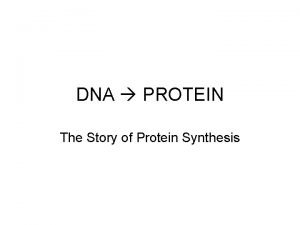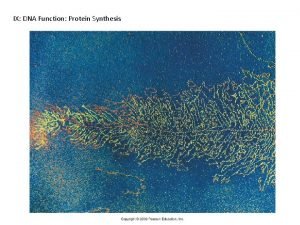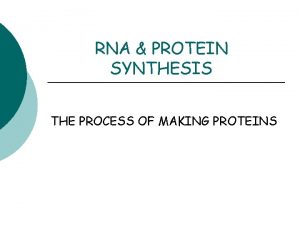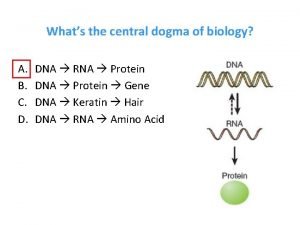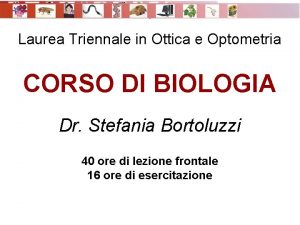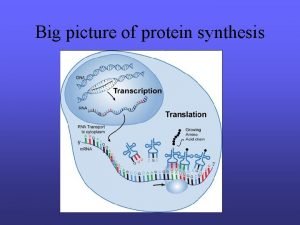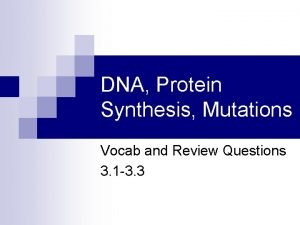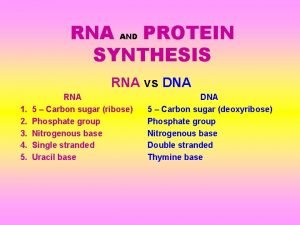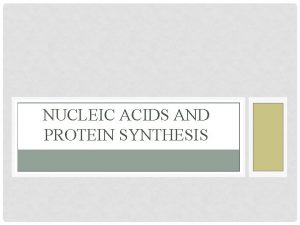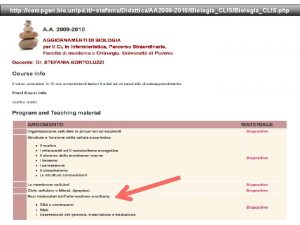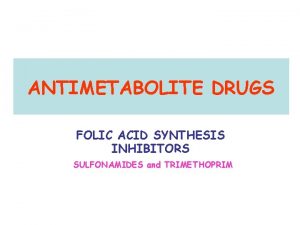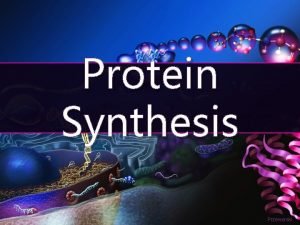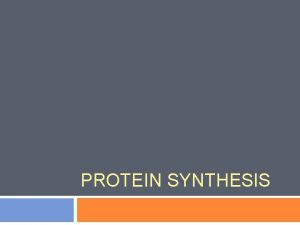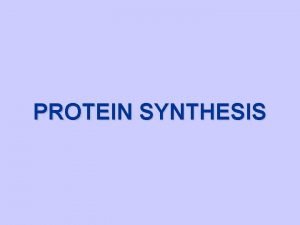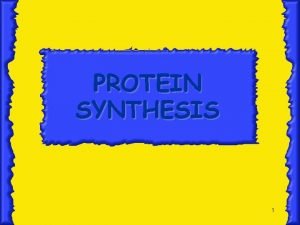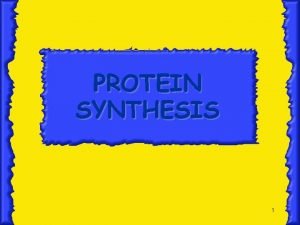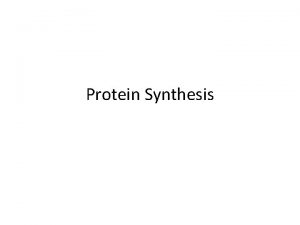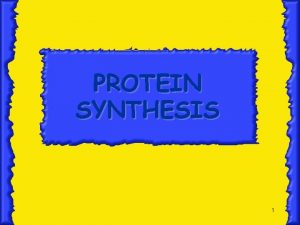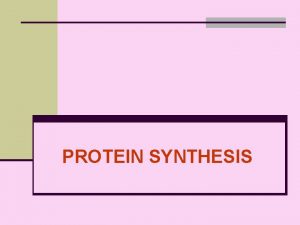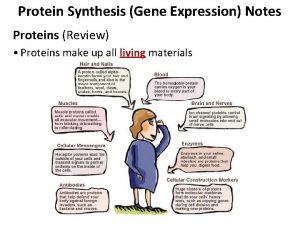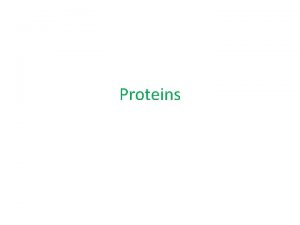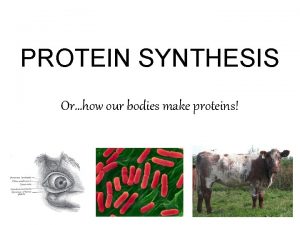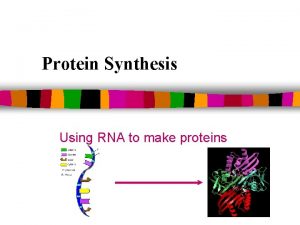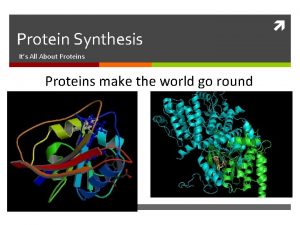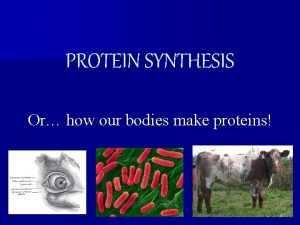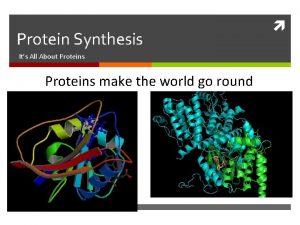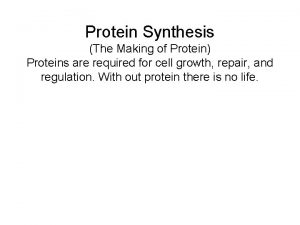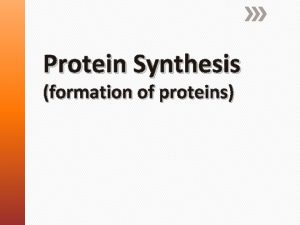Protein Synthesis to make proteins What is Protein



























- Slides: 27

Protein Synthesis (to make proteins)

What is Protein Synthesis? Flow of Genetic Information: DNA RNA Protein DNA holds the code for protein synthesis but cannot leave the nucleus

Protein Synthesis is performed at the ribosomes in the cytoplasm The cell uses RNA to copy the code from DNA and bring it to the ribosomes

RNA – Ribonucelic Acid I. Nitrogenous Bases a. Adenine b. Cytosine c. Guanine d. Uracil II. Simple Sugar – a ribose rather than a deoxyribose Phosphate Groups III.

II. Structure a. A nucleic acid backbone b. single strand of nucleotides c. Sugar is ribose d. Contains uracil base instead of thymine

Difference between DNA and RNA u Double strand u Deoxyribose u Thymine RNA single strand ribose uracil

III. Types of RNA Three types of RNA are used to make proteins a. m. RNA – messenger RNA b. r. RNA – ribosomal RNA c. t. RNA – transfer RNA

IV. m. RNA Function A. transcribe DNA code B. take code outside of nucleus to ribosome C. give instructions to ribosome on how to build protein

How does DNA transfer info to RNA? A=U G=C T=A No T’s in RNA

V. t. RNA Function u To deliver amino acids to the ribosome as it is building (synthesizing) protein

VI. r. RNA Function u where translation of RNA to protein takes place u Ribosomes are made up of protein and ribosomal RNA (r. RNA)

Remember: How many different amino acids are there? 20 Look at your notes - What makes each amino acid different from one another? R groups

VIII. The CODE!! A. James Watson and Francis Crick, with the help of Rosalind Franklin’s X-ray crystallography images unraveled the structure of DNA: B. The fact that bases paired led directly to a theory of how DNA codes for proteins. It took a few years to determine that the bases spell threeletter “words” called codons

m. RNA Codons u 3 letters on m. RNA are called codons. These three letter codes are used to determine which Amino Acid is to be placed on the protein. Ex: TAC AUG = Start Codon (Methionine) This is where you begin translation of DNA’s code given to m. RNA

See the m. RNA codon chart (slime green) u Write the codon for Proline here: u Glycine? u Which amino acid has the most codons? u Which amino acid has the fewest? u Start codon starts each protein u Three codons tell a ribosome to stop making a protein. List them here:

Transcription? - Copying the portion of DNA that carries the code for a protein. http: //www. youtube. com/watch? v=zt. Pkv 7 wc 3 y. U&feature=related m. RNA Synthesis (Transcription begins with a promoter on DNA, site RNA polymerase binds to on DNA to begin transcription). - A m. RNA is transcribed (built) using unwound DNA’s code as a template. - RNA nucleotides find their compliment. - RNA Polymerase is the enzyme that brings in the nucleotides

- Completed when reaches terminator sequence on DNA – ending transcription The original strand is used as the template.

Result: The resulting m. RNA looks exactly like the template strand of DNA, with one important distinction each T is replace with a U. http: //www. youtube. com/watch? v=Jqx 4 Y 0 Oj. WW 4&fea ture=related Where does it go? The RNA releases from DNA and is then edited before leaving the nucleus


Practice Transcription DNA Strand 3 ‘ T A C G A T G C A T C G 5’ RNA Strand 5 ‘ A U G C U A C G U A G C 3’ http: //www. youtube. com/watch? v=Njcz. QKj. Fcks&feature=related

Translation - The process of interpreting m. RNA to build a chain of amino acids that make up a protein. http: //www. youtube. com/watch? v=B 6 O 6 u. Rb 1 D 38&feature=related

How does it work? i. m. RNA leaves the nucleus and heads to the cytoplasm where the ribosomes are located. Remember: Ribosomes are where translation will occur • Each sequence of nucleotides is a codon (m. RNA codon). Each codon codes for a specific amino acid

ii. Amino acids are brought to the ribosome by t. RNA. • There are 20 different t. RNA molecules, one for each type of amino acid. • t. RNA anticodon finds their complimentary codon on m. RNA.

Anticodon – 3 letters found to match the m. RNA’s codon. – m. RNA codon: UAA CGA GGC – t. RNA anticodon: AUU GCU CCG

iii. Peptide bonds form between the amino acids forming a polypeptide. i. V. Translation stops when a stop codon is reached. Video: http: //www. youtube. com/watch? v=41_ Ne 5 m. S 2 ls&feature=related


Video: http: //www. youtube. com/watch? v=983 l hh 20 r. GY&feature=related
 Monomers that make up proteins
Monomers that make up proteins Protein synthesis cookie analogy
Protein synthesis cookie analogy Rna protein synthesis
Rna protein synthesis Section 12 3 rna and protein synthesis
Section 12 3 rna and protein synthesis Protein synthesis
Protein synthesis Sintese de proteinas na celula
Sintese de proteinas na celula Protein synthesis ppt
Protein synthesis ppt Protein synthesis
Protein synthesis Protein synthesis story
Protein synthesis story Translation
Translation Protein synthesis
Protein synthesis Concept map of protein synthesis
Concept map of protein synthesis Translation protein synthesis
Translation protein synthesis Whats the central dogma of biology
Whats the central dogma of biology Section 12 3 rna and protein synthesis answers
Section 12 3 rna and protein synthesis answers Protein synthesis
Protein synthesis Picture transcription
Picture transcription Protein synthesis and mutations
Protein synthesis and mutations Protein synthesis and mutations
Protein synthesis and mutations Protein synthesis gcse
Protein synthesis gcse Dna vs rna venn diagram
Dna vs rna venn diagram Protein synthesis
Protein synthesis Nucleic acids are made up of
Nucleic acids are made up of Protein synthesis
Protein synthesis Dna and rna
Dna and rna Messenger rna codons
Messenger rna codons Protein synthesis
Protein synthesis Protein synthesis inhibitor
Protein synthesis inhibitor
